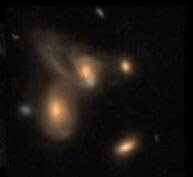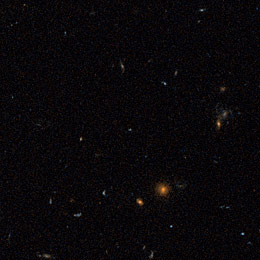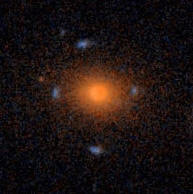UC Berkeley Press Release
 A small piece of the Extended Groth Strip, where each point is a galaxy a fraction of the distance to the edge of the universe. Snapped by the Hubble Space Telescope, many such images were assembled into a panorama of the entire strip. (Credit: NASA, ESA, M. Davis [UC Berkeley], S. Faber [UC Santa Cruz], and A. Koekemoer [STScI]) |
Full-spectrum study of small patch of sky yields portrait of maturing universe
BERKELEY – A massive project to generate an all-color map of the galaxies in a small area of sky, utilizing four satellite telescopes and four ground-based telescopes, is yielding new information about the universe's "pre-teen" years and the early evolution of galaxies and galaxy clusters.
Called the All-wavelength Extended Groth Strip International Survey (AEGIS), the five-year project involved the cooperation of more than 50 researchers from around the world observing the same small region of sky in the radio, infrared, visible, ultraviolet and X-ray regions of the electromagnetic spectrum. The target area, called the Extended Groth Strip, covers an area the width of two full moons that is a hop, skip and a jump from the end of the Big Dipper's handle.
 While the adolescent universe revealed by the Hubble Space Telescope images contained many galaxies that look normal to us, there were also many oddball galaxies. In this image, the two largest galaxies are clearly interacting. One of the spiral arms of the upper galaxy has been distorted toward the lower galaxy by the strong tidal forces of the interaction. These tidal distortions of galaxies are a dead give-away that a galaxy collision is underway. |
"The goal was to study the universe as it was when it was about half as old as it is at present," said team leader Marc Davis, professor of physics and astronomy at the University of California, Berkeley. "We've gotten such fabulous data; it just blows your socks off."
A total of 19 papers based on the Groth Strip survey have been accepted for publication in the Astrophysical Journal (ApJ) Letters, and will appear in a special issue in early spring. All currently are posted online.
Combined with spectra of these galaxies obtained through the W. M. Keck Telescope in Hawaii as part of the DEEP2 Galaxy Redshift Survey, the dataset will be an invaluable resource for astronomers, he said. Among the discoveries so far are a giant red galaxy with two black holes at its core; several new gravitational lenses - that is, galaxies whose gravity bends the light from background galaxies into multiple images; and a rogues' gallery of weird galaxies that astronomers will be busy trying to explain for decades.
To the naked eye, the Extended Groth Strip, named for Princeton University physicist Edward Groth, is empty, but the AEGIS survey pinpointed more than 150,000 galaxies in the strip. A panoramic mosaic of Hubble Space Telescope images released today (Tuesday, March 6) provides detailed, color images of at least 50,000 galaxies in part of this area. The AEGIS survey is focused on studying galaxies up to 9 billion years back in time - more than half way to the birth of the universe 13.7 billion years ago. It covers a period when galaxies were settling down after an early phase of rapid star formation.

The large red galaxy in the lower half of this Hubble Space Telescope image may look unassuming, but a spectrum obtained by the Keck II telescope shows clearly there are two massive objects at its core (see inset below). Based on AEGIS survey observations in the X-ray, optical, infrared and radio wavebands, UC Berkeley researchers concluded that there are two black holes at the center, probably resulting from an earlier merger of two galaxies
Binary black holes hint of past galactic merger
 Many astronomers suspect that all galaxies have a massive black hole at the center, though only those with matter falling into them are visible, becoming what is referred to as an active galactic nucleus. Quasars are among the brightest examples of these objects. When two galaxies merge, their central black holes should end up together at the core, eventually spiraling into one another. However, while galaxy mergers have been observed in abundance, few cases of galaxies with multiple massive black holes are known. Such objects may be difficult to find, as both black holes must be actively accreting matter for them to be visible.
Many astronomers suspect that all galaxies have a massive black hole at the center, though only those with matter falling into them are visible, becoming what is referred to as an active galactic nucleus. Quasars are among the brightest examples of these objects. When two galaxies merge, their central black holes should end up together at the core, eventually spiraling into one another. However, while galaxy mergers have been observed in abundance, few cases of galaxies with multiple massive black holes are known. Such objects may be difficult to find, as both black holes must be actively accreting matter for them to be visible.
Plumbing the DEEP2 data, UC Berkeley graduate student Brian Gerke discovered a double black hole in a galaxy about 6 billion light years away, at z=0.7. He confirmed the presence of an active galactic nucleus with AEGIS observations from the Chandra X-ray satellite. The two black holes are about 4,000 light years apart, one of them 500,000 and the other 5 million times the mass of the Sun. Their separation is small compared to the object’s distance from us; so that, even in high-resolution images from the Hubble Space Telescope, they are blurred together at the center of a fairly normal looking, elliptical galaxy.
Evidently, he said, what we are seeing is the combination of two galaxies that merged hundreds of millions of years earlier. Since the merger, the central black holes have spiraled toward one another to the distance we now observe. Though other dual black holes have been seen closer to Earth (notably NGC6240), they generally are visible only in X-ray or radio. This pair is visible in the optical. This is apparently because the host galaxy was formed from the combination of two "red and dead," elliptical or lenticular galaxies, which contain little of the obscuring dust that enshrouds the centers of mergers of star-forming galaxies (these galaxies are commonly referred to as “red and dead” because their star formation ceased at least a billion years ago, so their short-lived blue stars have all died).
There has been indirect evidence from studies of the galaxy population as a whole that mergers of red galaxies must have occurred in the distant past, but most tracers of these mergers are undetectable at large distances, making this object valuable for understanding galaxy evolution.
"This tells us where massive ellipticals come from – the merger of smaller galaxies," Gerke said.
"We're studying a key epoch when galaxies appear to be taking on their final mature forms," said Sandra Faber, professor of astronomy at UC Santa Cruz. "It's like seeing people at the age of 10 - they are not exactly infants, but they differ substantially from adults. We are watching galaxies grow up."
In a summary paper now posted online in ApJ Letters, Davis and his colleagues note that AEGIS is providing a unique combination of deep, intensive observations over a wide area, yielding large samples even of rare types of galaxies. They contrast their work with the Sloan Digital Sky Survey, which has observed the local universe in great detail, but focuses on only the last 2 billion years of cosmic evolution.
"We have looked at this patch of sky with every possible telescope, at wavelengths covering nine orders of magnitude - that's a wavelength range of a billion, compared to the ability of our eyes to see a range of two," said cosmologist Jeffrey A. Newman, a Hubble Fellow at Lawrence Berkeley National Laboratory. "Each provides a little piece of the puzzle of how galaxies evolve."
"As of this time, there is no other region this large on the sky that has been looked at so deeply in so many different wavelengths," Faber said. "This is the first truly panchromatic look at the universe more than halfway back in time."
Clues about the universe's youth, from 'pre-teen' years to young adulthood
According to Newman, the Hubble Space Telescope images reveal a time when galaxies were starting to reach maturity.
"We see a wide diversity of galaxies. Some are beautiful spirals or massive elliptical galaxies like those seen in the nearby universe, but others look like random assemblages of material, the leftovers from violent mergers of young galaxies. These resemble some of the most distant, youngest galaxies observed," he said.
AEGIS provides many windows on this time of transition. Ultraviolet and far-infrared light from newly-born stars, observed by the GALaxy Evolution eXplorer (GALEX) and the Spitzer Space Telescope, respectively, shows that stars were being formed at a much higher rate than today. Mid- and near-infrared light measures the total mass of the stars in each galaxy, allowing astronomers to see how galaxies grow larger over time, while X-ray and radio observations by the Chandra Space Telescope and the Very Large Array in New Mexico, respectively, can reveal the presence of powerful black holes at galaxies' centers.
A linchpin for AEGIS studies, Davis said, is the DEEP2 Redshift Survey, which measures many properties of a galaxy - its mass, the rate at which it is forming stars, and more - while simultaneously determining how far away it is, and, hence, how far back in time we're observing. The large number of objects surveyed by DEEP2 in the Groth Strip - 14,000 to date, though the completed survey should include nearly 18,000 galaxies - allows astronomers to see trends as the universe ages. The data clearly show that the galaxies at the far edge of the survey, around 9 billion years ago, are noticeably different from those at the near, 7 billion-year edge of the survey, which look more like "normal" galaxies today.
Because of the relatively large cosmic volume covered, astronomers are able to find even rare objects, such as galaxies with two separate black holes at their centers, that can help reveal the hidden physics of galaxy formation and evolution.
Lensing galaxies and an Einstein Cross
 A careful search of the tens of thousands of galaxies in the Hubble Space Telescope images revealed a classic "Einstein Cross," created when a massive foreground galaxy bends light from a background galaxy into our line of sight. Such an object allows astronomers to confirm the total amount of matter along the line of sight, since it ought to match up with what the gravitational lens models imply. |
The new survey also revealed two new lensing galaxies, an already known Einstein Cross - a case where a massive galaxy has split the light from a background galaxy into four arcs - and four possible lenses. According to Puragra "Raja" Guhathakurta of UC Santa Cruz's Lick Observatory, astronomers can apply Einstein's theory of general relativity to calculate the masses of lensing galaxies given their spectra and the observed bending of starlight.
The AEGIS data were supplied by the orbiting Hubble (optical), Chandra (X-ray), GALEX (ultraviolet) and Spitzer (infrared) telescopes, all operated by the National Aeronautics and Space Administration (NASA). The Canada-France-Hawaii Telescope atop Mauna Kea contributed optical data; California's Palomar Telescope provided near-infrared data; the Very Large Array in New Mexico provided radio observations; and the DEep Imaging Multi-Object Spectrograph (DEIMOS) instrument on the 10-meter Keck II telescope provided spectra of the galaxies. The full set of AEGIS data are planned to be released to the public in August 2007.
The AEGIS collaboration has been supported by the National Science Foundation and the NASA. The DEEP2 survey, funded by NSF and led by Davis and Faber, is a collaboration between astronomers at UC Berkeley, UC Santa Cruz and the University of Hawaii.
Useful links:

